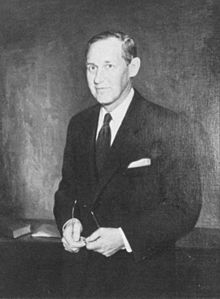Harry Hopkins
| Harry Hopkins | |
|---|---|
 |
|
| 8th United States Secretary of Commerce | |
|
In office December 24, 1938 – September 18, 1940 |
|
| President | Franklin D. Roosevelt |
| Preceded by | Daniel C. Roper |
| Succeeded by | Jesse H. Jones |
| Personal details | |
| Born |
Harry Lloyd Hopkins August 17, 1890 Sioux City, Iowa United States |
| Died | January 29, 1946 (aged 55) New York City, New York, United States |
| Cause of death | stomach cancer |
| Resting place | Hazelwood Cemetery, Grinnell, Iowa, United States |
| Political party | Democratic |
| Spouse(s) | Ethel Gross Hopkins (m. 1913 - 1929, divorced) Barbara Duncan Hopkins (died 1937) Louise Macy Hopkins |
| Children | David Hopkins Robert Hopkins Stephen P. Hopkins Barbara Hopkins Diana Hopkins |
| Alma mater | Grinnell College |
| Profession | Government |
Harry Lloyd Hopkins (August 17, 1890 – January 29, 1946) was one of Franklin Delano Roosevelt's closest advisers. He was one of the architects of the New Deal, especially the relief programs of the Works Progress Administration (WPA), which he directed and built into the largest employer in the country. In World War II, he was Roosevelt's chief diplomatic adviser and troubleshooter and was a key policy maker in the Lend-Lease program that sent an eventual $50 billion aid to the Allies; Winston Churchill devotes in his memoirs to this "natural leader of men" who had "a flaming soul" a veritable panegyric. Hopkins dealt with "priorities, production. political problems with allies, strategy—in short, with anything that might concern the president."
Hopkins was born at 512 Tenth Street in Sioux City, Iowa, the fourth child of four sons and one daughter of David Aldona and Anna (née Pickett) Hopkins. His father, born in Bangor, Maine, ran a harness shop (after an erratic career as a salesman, prospector, storekeeper and bowling-alley operator), but his real passion was bowling, and he eventually returned to it as a business. Anna Hopkins, born in Hamilton, Ontario, had moved at an early age to Vermillion, South Dakota, where she married David. She was deeply religious and active in the affairs of the Methodist church. Shortly after Harry was born, the family moved successively to Council Bluffs, Iowa, and Kearney and Hastings, Nebraska. They spent two years in Chicago and finally settled in Grinnell, Iowa.
Hopkins attended Grinnell College and soon after his graduation in 1912 took a job with Christodora House, a social settlement house in New York City's Lower East Side ghetto. In the spring of 1913, he accepted a position from John A. Kingsbury of the New York Association for Improving the Condition of the Poor (AICP) as "friendly visitor" and superintendent of the Employment Bureau within the AICP's Department of Family Welfare. During the 1915 recession, Hopkins and the AICP's William Matthews, with $5,000 from Elizabeth Milbank Anderson's Milbank Memorial Fund, organized the Bronx Park Employment program, one of the first public employment programs in the U.S.
...
Wikipedia
